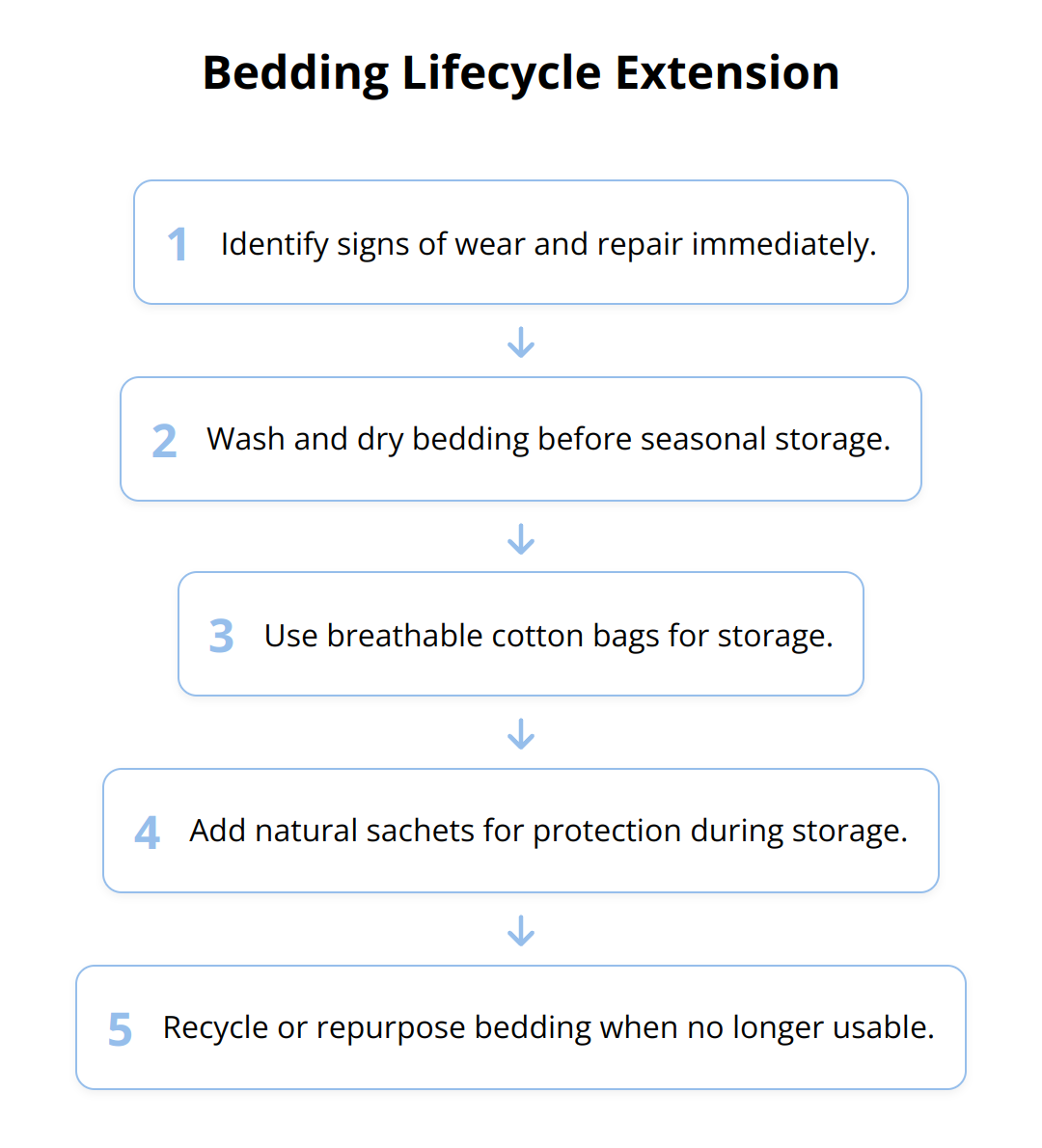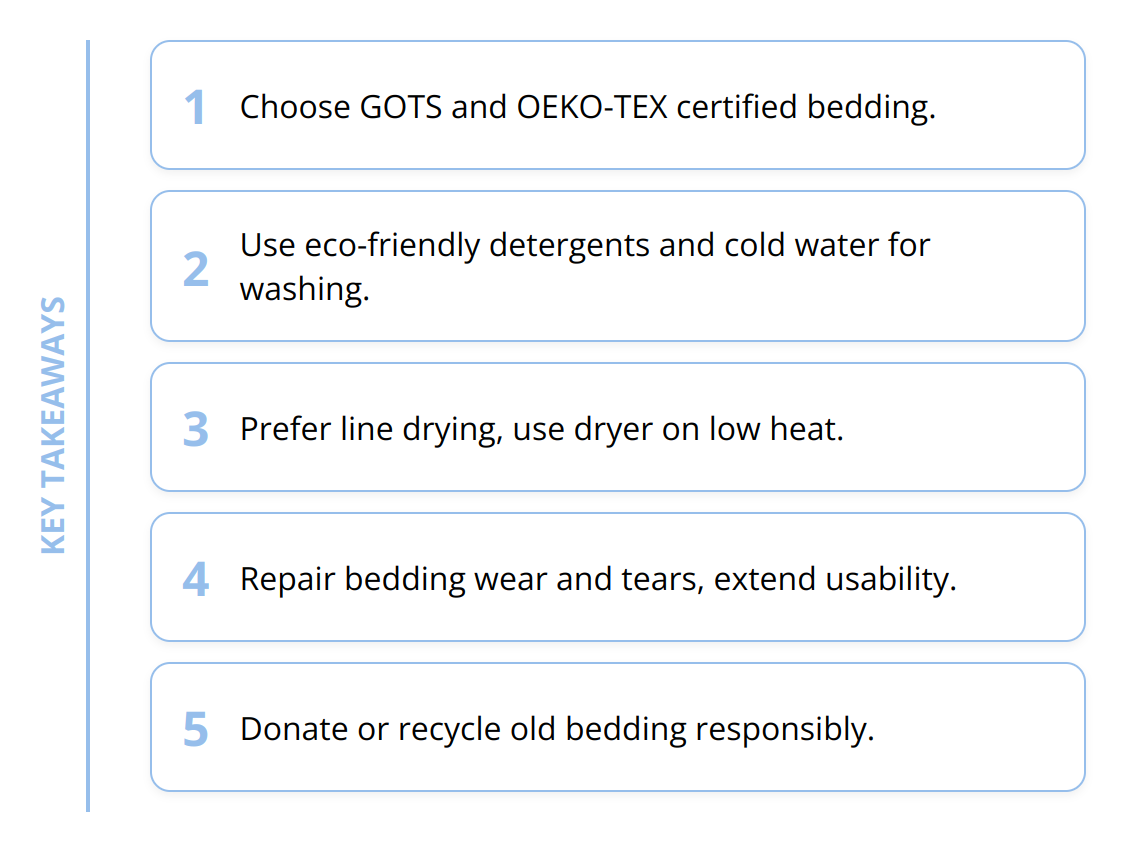At The A Team Cleaning Services, we believe in the power of eco-friendly practices, especially when it comes to home care. Sustainable living starts with the choices we make daily, including how we care for our bedding.
This post will guide you on selecting sustainable materials, maintaining them properly, and extending their lifespan while keeping our planet in mind. Through simple, practical steps, you can make a significant impact.
Choosing Sustainable Bedding
When it comes to bedding, selecting materials that not only offer comfort but are also kind to our planet is pivotal. Organic cotton, bamboo, and linen stand out as top choices for those seeking to integrate sustainability into their sleep routines.

Organic cotton is renowned for its breathability and softness. What makes it sustainable is its cultivation process, which foregoes synthetic pesticides and fertilizers, thereby reducing water pollution and conserving biodiversity. When purchasing organic cotton bedding, look for the Global Organic Textile Standard (GOTS) certification. This ensures the cotton is not only grown organically but processed ethically as well.
Bamboo stands out for its exceptional softness and durability. It is inherently moisture-wicking and offers natural anti-bacterial properties, making it ideal for a hygienic sleep environment. Bamboo grows quickly and usually doesn’t need chemicals, making it a sustainable crop. However, it’s essential to research and opt for bamboo processed through eco-friendly methods, avoiding those treated with harsh chemicals.
Linen, made from the flax plant, uses far less water than cotton, and its durability means it lasts longer. Linen is completely biodegradable when not dyed and is highly breathable, making it perfect for both warm and cool sleepers. Its natural texture and appearance add a simple, yet luxurious, aesthetic to any bedroom.
Looking for certifications can guide you to more sustainable choices. The OEKO-TEX Standard is another label to consider; it guarantees that the finished textile product is free from harmful substances.
Sourcing eco-friendly bedding can be straightforward if you know where to look. Many online retailers specialize in sustainable home goods. Trusted e-commerce platforms often filter options so you can choose sustainable, certified products easily. Additionally, visiting local markets and choosing artisanal products can support small businesses while ensuring you receive high-quality, sustainable bedding.

Here are a few actionable tips to ensure your bedding choices are as green as possible:
-
Prioritize GOTS and OEKO-TEX certified products.
-
Research brands committed to sustainable practices.
-
Consider the lifespan and care requirements of the material.
-
Recycle or donate old bedding instead of throwing it away.
For further insights on sustainable living, reading through guides like sustainable living practices can be immensely helpful.
In making these mindful choices, not only do you contribute to a healthier planet, but you also invest in your well-being. Sustainable bedding is not just about the material; it’s a choice that reflects a commitment to a better, cleaner world.
Sustainable Bedding Care
Caring for your sustainable bedding correctly is essential in extending its life and maintaining its quality. The right techniques not only contribute to a cleaner environment but also ensure that your bedding remains in top condition for years. Here’s how you can approach it:
Washing Sustainable Bedding
The key to washing sustainable bedding is to do it gently and with eco-friendly detergents. Organic cotton, bamboo, and linen benefit greatly from cold water cycles, which significantly reduce energy usage compared to hot water washes. Additionally, opting for natural detergents that are free from harsh chemicals protects the fabric’s fibers and is kinder to the planet. For stubborn stains on organic cotton bedding, natural solutions like vinegar or lemon juice can be surprisingly effective.
-
Always follow the care label
-
Use cold water settings
-
Opt for eco-friendly detergents
Dry and Iron with Care
After washing, drying your sustainable bedding in a way that conserves energy and maintains fabric integrity is crucial. Whenever possible, line drying is the best option. It uses zero electricity and the sun’s natural UV rays help to disinfect the fabric. However, when line drying isn’t an option, using a dryer on a low heat setting is preferable. As for ironing, it’s best done when the fabric is slightly damp. This method requires less energy and is more effective in removing wrinkles.
-
Prefer line drying
-
Use the dryer on low heat
-
Iron when slightly damp
To maintain the freshness of your bedding without frequent washes, air it out regularly. This simple practice can extend the time between washes, saving water and energy. For an added touch of freshness, consider incorporating essential oils like lavender into your laundry; a few drops can infuse your bedding with a pleasant, calming scent.
Natural Cleaning Products
Switching to natural cleaning products is not just great for your bedding but also for the environment. Ingredients like baking soda, Castile soap, and white vinegar are not only effective in cleaning but are also biodegradable and free from toxic residues. These alternatives are safe for most sustainable fabrics and can handle everything from general cleaning to stain removal.
-
Baking soda for general freshness
-
Castile soap for a gentle wash
-
White vinegar for stain removal

Taking care of your sustainable bedding with these eco-friendly practices ensures that your efforts to choose environmentally friendly materials come full circle. By washing with care, opting for natural drying methods, and using green cleaning products, you contribute to a sustainable lifestyle that benefits both your home and the planet.
For more tips on maintaining a sustainable living space, explore our guide on eco-friendly cleaning routines.
Extending Bedding Lifespan
Making sustainable bedding last longer is not just beneficial for your wallet—it’s essential for reducing waste and supporting a healthier planet. Through mindful use, proper repair, and appropriate storage, you can dramatically extend the life of your bedding. This chapter offers practical advice on keeping your bedding in excellent condition for as long as possible.
Repair Before Replacement
The first sign of wear or a minor tear doesn’t mean your bedding is destined for the landfill. Quite the contrary, a little TLC can give it new life. For sheets, duvet covers, or pillowcases with small rips or loose threads, mend them promptly. Sewing a patch or using iron-on patches for bigger tears can add unique charm while extending the usability of your items. Being proactive about repairs not only saves resources but also allows you to cherish your favorite bedding pieces longer.

Smart Seasonal Storage
Proper storage is key to preserving the quality of your bedding during off-season months. Wash and thoroughly dry your seasonal bedding before storing it to prevent mold and mildew growth. Use breathable cotton storage bags instead of plastic ones to encourage air circulation and keep fabrics fresh. Storing them in a cool, dry place ensures that your bedding remains pristine until you’re ready to use it again. For added protection, consider adding natural sachets of lavender or cedar blocks to ward off pests without resorting to chemicals.
Responsible Recycling
There comes a time when even the best-cared-for bedding reaches the end of its usable life. When replacement is inevitable, recycling or repurposing becomes key. Many communities offer textile recycling programs where old bedding can be given a second life as insulation, cleaning rags, or other useful items. Alternatively, donating bedding that’s still in good condition to shelters or animal rescue organizations can make a positive impact. If repurposing at home, consider cutting old sheets into cleaning cloths or crafting them into reusable shopping bags.

By adopting these practices, you’ll not only extend the life of your bedding but also contribute to a larger effort of reducing waste and promoting sustainability. For more insights on eco-friendly living practices, you might find our guide on eco-friendly cleaning hacks particularly useful.
Embracing these steps ensures that your commitment to a sustainable lifestyle is reflected in how you care for and maximize the longevity of your bedding.
Final Thoughts
Sustainable living extends far beyond the choice of products; it envelops our entire lifestyle, including how we care for our homes and bedding. The steps outlined earlier, from choosing sustainable materials for your bedding to adopting eco-friendly habits in its care and maintenance, showcase a commitment to not just personal health but also the well-being of our planet. By prioritizing materials like organic cotton, bamboo, and linen, and caring for them in a way that minimizes environmental impact, we can all contribute to a healthier world.

The importance of selecting sustainable materials cannot be overstated. These choices support a sustainable cycle of production and consumption, reducing the carbon footprint and promoting biodiversity. Coupled with the correct care—such as using cold water, eco-friendly detergents, and natural drying methods—we ensure these items last longer, reducing waste and further promoting sustainability.
We at The A Team Cleaning Services encourage you to extend these eco-friendly practices to all areas of home care. Our professional house cleaning service is designed to align with your commitment to a clean, safe, and sustainable living environment. Using professional-grade products and tailored cleaning plans, we help maintain the pristine condition of your home, allowing you to enjoy a fresh, inviting space without the added environmental footprint.
As you integrate these sustainable practices into your daily routine, remember that even small changes can have a profound impact. We invite you to explore more ways to foster a greener home on our blog.
Together, let’s make a commitment to not just live sustainably, but to thrive sustainably. Adopting eco-friendly habits in bedding care is just the beginning. Let’s continue to explore and embrace new ways to care for our homes and our planet, for today and all tomorrows to come.
